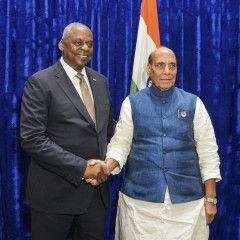
A file photo.
SRIHARIKOTA (PTI): Indian Space Research Organisation will flight test its indigenously developed cryogenic engine onboard a Geo-Synchronous Satellite Launch Vehicle by mid-2012.
“Our target is to launch the GSLV (D5) by June 2012 with indigenously developed cryogenic engine. Currently, a series of ground testing are on,” ISRO Chairman K Radhakrishnan told reporters here.
Speaking after the successful launch of GSAT-12 onboard homegrown PSLV-C17 from here, he said the GSLV rocket would be used to launch communication satellite GSAT-14.
“We have had two failures – GSLV-F06 and GSLV-D3. We have identified the reasons and corrective actions are being taken,” he said.
GSLV-F06 was used to launch communications satellite GSAT-5P in December 2010 and GSLV-D3 to launch GSAT-4 in April 2010, but both missions failed following some problems in the complex cryogenic stage.
On the progress of Chandrayaan-II mission, ISRO Space Commission Member and Director T K Alex said it was expected in the beginning of 2014.
“It is in progress. This time we are examining the lander, rover and the orbiter. The designing stage has been completed. The prototype of the rover is being made in Bangalore and the testing is going on,” he added.
The Russian Space Agency was involved in developing the rover. “By 2014 beginning, GSLV will launch Chandrayaan-2, estimated to cost Rs 425 crore,” he said.
On India’s first manned Moon mission, Radhakrishnan said they were studying various aspects including the crew module.
“The Government has sanctioned Rs 145 crore for this and we need to consider various aspects well in advance including crew escape system, flight suit for crew members, environmental control,” he said.
“PSLV is not sufficient for the manned mission and we have identified GSLV Mark III would be more sufficient as it can accommodate three crew members. Either GSLV or GSLV Mark III will be the two candidates for this project,” he said.
PSLV-C17/GSAT-12 Project Director T K Anuradha said a team of three women scientists, including her, would monitor the satellite from the Master Control Facility in Hassan in Karnataka from Saturday.
During the days to come, various manoeuvres including deployment of antenna and switching on the payload would be carried out, she said.
“From tomorrow next five days will be crucial... We will have antenna deployment and after 10 days, satellite will start drifting...then we will need to switch on the payload...,” she said.
 Previous Article
Previous Article Next Article
Next Article













The Indian Air Force, in its flight trials evaluation report submitted before the Defence Ministry l..
view articleAn insight into the Medium Multi-Role Combat Aircraft competition...
view articleSky enthusiasts can now spot the International Space Station (ISS) commanded by Indian-American astr..
view article